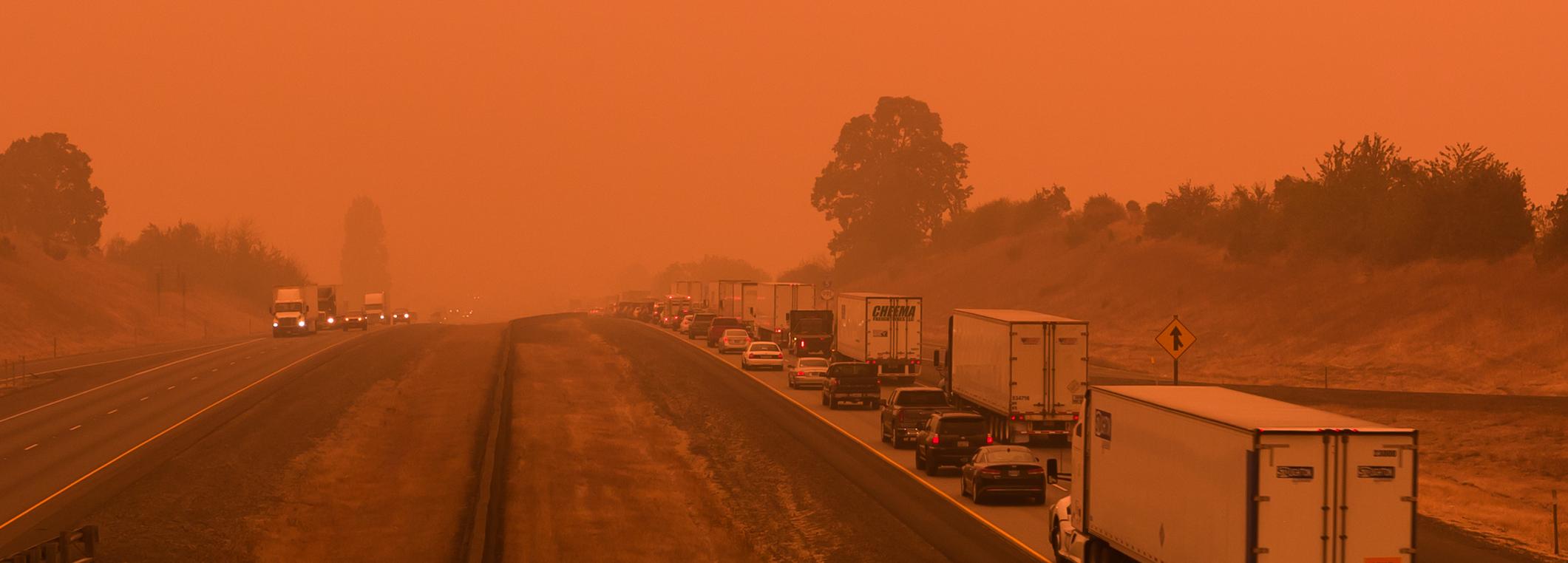
The Rising Importance of Supply-Chain Resilience
-
bookmark
-
print
Many corporate leaders in Canada and the U.S. have been creating climate mitigation plans to address business risks. In the wake of the Los Angeles wildfires, which caused incalculable suffering and losses estimated at more than US$250 billion1, it’s clear that those plans will need to factor in supply-chain resilience.
Modern supply chains are so intricately interwoven that leaders may not always be clear where their exposure lies until disaster strikes. Organizations do not need to have headquarters or even direct operations in an area affected by a disaster related to extreme weather to experience operational disruptions.
Organizations do not need to have headquarters or even direct operations in an area affected by a disaster related to extreme weather to experience operational disruptions.
A peek into the climate future
Racing across southern California in midwinter, months before the usual wildfire season, the Los Angeles fires destroyed more than 16,000 homes and business premises,2 as well as infrastructure including roads, bridges, and power lines, and saw almost 200,000 people placed under evacuation orders at their peak.3
Nearly 1,900 small businesses are estimated to have fallen within the fire burn area,4 and the impacts for many were significant. Some companies had to shutter temporarily due to evacuation orders, staff shortages, loss of power and/or data, or road closures; others may shutter permanently, their capital destroyed. Still more suffered disruption from factors such as school closures, transportation challenges, and wildfire smoke.
While the supply-chain impacts were relatively limited, it's an indicator of things to come. Despite hopes that the world would benefit from the cooling impact of the La Niña weather pattern, this January was the hottest on record.5 In addition, extreme weather events including droughts, floods, heatwaves and wildfires are becoming much more likely.6
Supply-chain risks
Everything from metals to timber to basic food items are vulnerable to supply-chain disruptions. Droughts and flooding endanger mine operations; forests are under pressure from extreme heat, drought, and wildfires; farmers are vulnerable to both extreme weather events and long-term climatic shifts. Previous work from the BMO Climate Institute found that, by 2050, Texas agriculture businesses may lose $890 million a year to drought, while wildfire losses in California agriculture may extend to $430 million.
Everything from metals to timber to basic food items are vulnerable to supply-chain disruptions.
As we saw in Los Angeles, climate events can affect workers in every sector. Extreme heat and cold snaps can reduce productivity or cause shutdowns; flooding, wildfires, hurricanes, and cold snaps can make it impossible for staff to reach their places of work.
Transportation networks can also be disrupted. More than half (55%) of the world’s trade goes through ports with significant vulnerability to climate risks: Hurricane Katrina shut down three ports that process 45% of the US’s agricultural goods.7 Heavy rains in British Columbia in 2021 led to flooding and landslides that disrupted both rail and road access to the port of Vancouver, Canada’s largest port.8
Energy is also vulnerable to extreme weather events. As well as hitting power infrastructure, Hurricane Ida shut down 96% of crude oil production and 94% of natural gas production in the Gulf region.9
Data is the backbone of the digital economy, but the physical infrastructure that supports it—data centers and communication networks—relies heavily on electricity and cooling. Cooling systems, in particular, often require significant amounts of water, making data facilities vulnerable to drought. In 2018, nearly one-fifth of the nation’s servers depended on water from already stressed watersheds.10
A roadmap for more resilient supply chains
Business leaders can take a proactive approach to make their supply chains more resilient using the following steps:
-
Ensure CFOs are partners in risk management. CFOs have an important role to play in both measuring and mitigating climate risks, applying lessons learned during the pandemic to both physical risks and the challenges of the energy transition.
-
Identify essential suppliers for business continuity. Then, work closely with them to conduct risk diagnostics and map climate change risks.
-
Work with vulnerable suppliers on risk mitigation. For example, in LA County, the fires are forecast to cause around $297 million in lost annual wages due to unemployment.11 Once key suppliers at risk from climate impacts are identified, businesses should support them in strengthening their resilience strategies.
-
Geographically diversify supply sources. Where possible, expand supply networks across different regions to reduce the impact of localized climate events.
-
Establish inventory buffers. Businesses may choose to strategically build inventory to better withstand supply chain disruptions.
As supply chains become ever more complex, so too does the risk nexus. Climate impacts such as water scarcity and food insecurity can lead to unrest, political instability, and conflict. But complexity is not a reason to avoid approaching a topic; in fact, it makes engagement even more urgent.
Footnotes:
1. Chang, A., Vincent, R., and Gerber, M. (2025, February 12). Behind the staggering economic toll of the L.A. wildfires. Los Angeles Times.
2. Li, Z, and Yu, W. (2025). Economic Impact of the Los Angeles Wildfires. UCLA Anderson Forecast.
3. Stelloh, T., Lenthang, M., Cohen R., and Helsel P. (2025, January 31). California wildfires: What we know about L.A.-area fires, what caused them, who is affected and more. NBC News.
4. Chang, A., Vincent, R., and Gerber, M. (2025, February 12).
5. (2025, February 6). It’s official: January was the warmest on record. UN News.
6. Extreme Weather and Climate Change. NASA.
7. (2020, September 12). Ports are highly exposed to climate change and often ill-prepared. The Economist.
8. (2022, March 29). How an ‘atmospheric river’ led to the disastrous isolation of the port of Vancouver. AXA Climate.
9. (2021, September 16). Hurricane Ida disrupted crude oil production and refining activity. U.S. Energy Information Administration.
10. Siddik, M. A. B., Shehabi, A., Marston, L. (2021, May 21). The environmental footprint of data centers in the United States. Environmental Research Letters, Volume 16, Number 6.
11. Li, Z, and Yu, W. (2025).

The Rising Importance of Supply-Chain Resilience
Head, BMO Climate Institute
Melissa leads BMO’s Climate Institute, a center of expertise accelerating climate solutions by bridging science, technology, policy, and finance. She is a glo…
Melissa leads BMO’s Climate Institute, a center of expertise accelerating climate solutions by bridging science, technology, policy, and finance. She is a glo…
VIEW FULL PROFILE-
Minute Read
-
Listen
Stop
-
Text Bigger | Text Smaller
Many corporate leaders in Canada and the U.S. have been creating climate mitigation plans to address business risks. In the wake of the Los Angeles wildfires, which caused incalculable suffering and losses estimated at more than US$250 billion1, it’s clear that those plans will need to factor in supply-chain resilience.
Modern supply chains are so intricately interwoven that leaders may not always be clear where their exposure lies until disaster strikes. Organizations do not need to have headquarters or even direct operations in an area affected by a disaster related to extreme weather to experience operational disruptions.
Organizations do not need to have headquarters or even direct operations in an area affected by a disaster related to extreme weather to experience operational disruptions.
A peek into the climate future
Racing across southern California in midwinter, months before the usual wildfire season, the Los Angeles fires destroyed more than 16,000 homes and business premises,2 as well as infrastructure including roads, bridges, and power lines, and saw almost 200,000 people placed under evacuation orders at their peak.3
Nearly 1,900 small businesses are estimated to have fallen within the fire burn area,4 and the impacts for many were significant. Some companies had to shutter temporarily due to evacuation orders, staff shortages, loss of power and/or data, or road closures; others may shutter permanently, their capital destroyed. Still more suffered disruption from factors such as school closures, transportation challenges, and wildfire smoke.
While the supply-chain impacts were relatively limited, it's an indicator of things to come. Despite hopes that the world would benefit from the cooling impact of the La Niña weather pattern, this January was the hottest on record.5 In addition, extreme weather events including droughts, floods, heatwaves and wildfires are becoming much more likely.6
Supply-chain risks
Everything from metals to timber to basic food items are vulnerable to supply-chain disruptions. Droughts and flooding endanger mine operations; forests are under pressure from extreme heat, drought, and wildfires; farmers are vulnerable to both extreme weather events and long-term climatic shifts. Previous work from the BMO Climate Institute found that, by 2050, Texas agriculture businesses may lose $890 million a year to drought, while wildfire losses in California agriculture may extend to $430 million.
Everything from metals to timber to basic food items are vulnerable to supply-chain disruptions.
As we saw in Los Angeles, climate events can affect workers in every sector. Extreme heat and cold snaps can reduce productivity or cause shutdowns; flooding, wildfires, hurricanes, and cold snaps can make it impossible for staff to reach their places of work.
Transportation networks can also be disrupted. More than half (55%) of the world’s trade goes through ports with significant vulnerability to climate risks: Hurricane Katrina shut down three ports that process 45% of the US’s agricultural goods.7 Heavy rains in British Columbia in 2021 led to flooding and landslides that disrupted both rail and road access to the port of Vancouver, Canada’s largest port.8
Energy is also vulnerable to extreme weather events. As well as hitting power infrastructure, Hurricane Ida shut down 96% of crude oil production and 94% of natural gas production in the Gulf region.9
Data is the backbone of the digital economy, but the physical infrastructure that supports it—data centers and communication networks—relies heavily on electricity and cooling. Cooling systems, in particular, often require significant amounts of water, making data facilities vulnerable to drought. In 2018, nearly one-fifth of the nation’s servers depended on water from already stressed watersheds.10
A roadmap for more resilient supply chains
Business leaders can take a proactive approach to make their supply chains more resilient using the following steps:
-
Ensure CFOs are partners in risk management. CFOs have an important role to play in both measuring and mitigating climate risks, applying lessons learned during the pandemic to both physical risks and the challenges of the energy transition.
-
Identify essential suppliers for business continuity. Then, work closely with them to conduct risk diagnostics and map climate change risks.
-
Work with vulnerable suppliers on risk mitigation. For example, in LA County, the fires are forecast to cause around $297 million in lost annual wages due to unemployment.11 Once key suppliers at risk from climate impacts are identified, businesses should support them in strengthening their resilience strategies.
-
Geographically diversify supply sources. Where possible, expand supply networks across different regions to reduce the impact of localized climate events.
-
Establish inventory buffers. Businesses may choose to strategically build inventory to better withstand supply chain disruptions.
As supply chains become ever more complex, so too does the risk nexus. Climate impacts such as water scarcity and food insecurity can lead to unrest, political instability, and conflict. But complexity is not a reason to avoid approaching a topic; in fact, it makes engagement even more urgent.
Footnotes:
1. Chang, A., Vincent, R., and Gerber, M. (2025, February 12). Behind the staggering economic toll of the L.A. wildfires. Los Angeles Times.
2. Li, Z, and Yu, W. (2025). Economic Impact of the Los Angeles Wildfires. UCLA Anderson Forecast.
3. Stelloh, T., Lenthang, M., Cohen R., and Helsel P. (2025, January 31). California wildfires: What we know about L.A.-area fires, what caused them, who is affected and more. NBC News.
4. Chang, A., Vincent, R., and Gerber, M. (2025, February 12).
5. (2025, February 6). It’s official: January was the warmest on record. UN News.
6. Extreme Weather and Climate Change. NASA.
7. (2020, September 12). Ports are highly exposed to climate change and often ill-prepared. The Economist.
8. (2022, March 29). How an ‘atmospheric river’ led to the disastrous isolation of the port of Vancouver. AXA Climate.
9. (2021, September 16). Hurricane Ida disrupted crude oil production and refining activity. U.S. Energy Information Administration.
10. Siddik, M. A. B., Shehabi, A., Marston, L. (2021, May 21). The environmental footprint of data centers in the United States. Environmental Research Letters, Volume 16, Number 6.
11. Li, Z, and Yu, W. (2025).
You might also be interested in
More U.S. and Canadian Companies Are Being Driven to Climate Action Because of Customer Expectations: Survey Shows

Financing Critical Minerals: Opportunities to Build New Investment Frameworks

Validating Breakthrough Energy Concepts, a Discussion with George Hathaway

How Developers and Builders Are Paving the Way for a Greener Future

From Farm to Future: How Funding Solutions are Shaping Agricultural Emissions
Why Sustainability Is Good Business: Key Takeaways from IEFA Toronto 2024

Building for Tomorrow: Real Estate, Construction, and Sustainability
Women Entrepreneurs are Advancing Sustainability: Reflecting on the Results of the WE Empower UN SDG Challenge

Canadian Zero-Carbon Multi-Unit Residential Buildings: An Analysis of the Cost and Asset Value

BMO Equity Research on the AI + Data Center Build Out: Sustainability Impacts, Second Order Beneficiaries

Making Renewable Energy Technology Accessible to Underserved Communities: GRID Alternatives in Conversation

Women are Leading Across the Landscape of Climate and Sustainability

The Role of Responsible Mining in the Clean Energy Transition: ICMM CEO Rohitesh Dhawan in Conversation

Extreme Temperatures: How North American Cities Amplify Climate Change

Transforming the Textile Industry: Apparel Impact Institute in Conversation

Protecting Outdoor Spaces: The Conservation Alliance in Conversation

Building Meaningful Connections with Nature: Parks California in Conversation

Free, Prior and Informed Consent (FPIC): Mark Podlasly in Conversation

Quick Listen: Michael Torrance on Empowering Your Organization to Operationalize Sustainability

Quick Listen: Darryl White on the Importance of US-Canada Partnership

North America’s Critical Minerals Advantage: Deep Dive on Community Engagement

Evolving Mining for a Sustainable Energy Transition: ICMM CEO Rohitesh Dhawan in Conversation

Public Policy and the Energy Transition: Howard Learner in Conversation

Quick Listen: Darryl White on the Economic Implications of a Rapidly-Aging Society

Taskforce on Nature-Related Financial Disclosure (TNFD) – A Plan for Integrating Nature into Business

ESG Trends in the Base Metal and Diversified Mining Industries: BMO Equity Research Report

COP27 in Focus: Will Energy Security and Economic Uncertainty Impact the Climate Transition?

RoadMap Project: An Indigenous-led Paradigm Shift for Economic Reconciliation

On-Farm Carbon and Emissions Management: Opportunities and Challenges

Sustainability Strategy and Reporting for Small and Medium Sized Companies: A Discussion at the Conference of Montreal

Investment Opportunities for a Net-Zero Economy: A Conversation at the Milken Institute Global Conference

How Hope, Grit, and a Hospital Network Saved Maverix Private Capital Founder John Ruffolo

Hydrogen’s Role in the Energy Transition: Matt Fairley in Conversation

Key Takeaways on Ag, Food, Fertilizer & ESG from BMO’s Farm to Market Conference

Building an ESG Business Case in the Food Sector: The Food Institute

Retrofitting Canada's Building Sector: Efficiency Canada’s Corey Diamond in Conversation

The Role of Hydrogen in the Energy Transition: FuelCell Energy CEO Jason Few in Conversation


Tackling Climate Change in Metals and Mining: ICMM CEO Rohitesh Dhawan in Conversation

The Post 2020 Biodiversity Framework – A Discussion with Basile Van Havre

The Risk of Permafrost Thaw on People, Infrastructure & Our Future Climate

Biggest Trends in Food and Ag, From ESG to Inflation to the Supply Chain

Understanding Biodiversity Management: Best Practices and Innovation

Episode 31: Valuing Natural Capital – A Discussion with Pavan Sukhdev

Episode 29: What 20 Years of ESG Engagement Can Teach Us About the Future

Episode 28: Bloomberg: Enhancing ESG Disclosure through Data-Driven Solutions

Episode 23: TC Transcontinental – A Market Leader in Sustainable Packaging

Episode 07: World Bank: Mobilizing Capital Markets for Sustainable Finance

Episode 06: Responsible Investing – Industry Trends and Best Practices from Canada












